spy
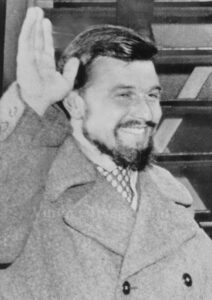 To most of us, committing espionage against our own country is…unthinkable, but there are those among us who wouldn’t give that a second thought. I think most countries have spies who do their best to find out information about another country, and I suppose that by design, that would mean that someone would have to commit espionage. I guess the two would go hand in hand, and it would depend on just how loyal a person was as to the limits they would go.
To most of us, committing espionage against our own country is…unthinkable, but there are those among us who wouldn’t give that a second thought. I think most countries have spies who do their best to find out information about another country, and I suppose that by design, that would mean that someone would have to commit espionage. I guess the two would go hand in hand, and it would depend on just how loyal a person was as to the limits they would go.
George Blake, who was born George Behar on November 11, 1922, was a British MI6 agent, and at one time thought to be a loyal agent, but during his time as a prisoner of war in Seoul, during the Korean War, he was apparently converted into a Communist, and strategically set up to be a double-agent. I suppose there is a number of prisoners of war who traded secrets for life and freedom from torture, and some who honestly changed their viewpoint, but to me it is outrageous. George Blake must  not have seen it that way, because he was a double-agent until he got caught in 1961.
not have seen it that way, because he was a double-agent until he got caught in 1961.
During his active double-agent years, he is believed to have betrayed the names of more than 40 British agents to the Soviets. Many of those he betrayed disappeared and were thought to have been executed. His betrayals basically destroyed British secret service operations in the Middle East. It must have been almost impossible to get agents to work in that region. Blake is believed to have passed on the names of almost every British agent working in Cairo, Damascus, and Beirut. Lord Parker, Lord 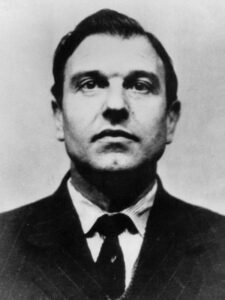 Chief Justice, the judge sentencing him, likened his actions to treason, and said, “It is one of the worst that can be envisaged other than in a time of war.” Blake was charged under the Official Secrets Act in May 1961. Blake pleaded guilty to five counts of passing secrets to the Soviet authorities during his trial, part of which was held in camera.
Chief Justice, the judge sentencing him, likened his actions to treason, and said, “It is one of the worst that can be envisaged other than in a time of war.” Blake was charged under the Official Secrets Act in May 1961. Blake pleaded guilty to five counts of passing secrets to the Soviet authorities during his trial, part of which was held in camera.
In 1966, Blake escaped from Wormwood Scrubs prison after serving five years of his sentence and having been removed from the list of likely escapers after only a year. Apparently, his supposed acceptance of his exceptionally long sentence lulled wardens into a false sense of security. It is assumed that he had help from the Soviet Union, and after his escape, he was quickly whisked away to the Soviet Union, where he lived out his life. He passed away in Moscow, Russia on December 26, 2020, at the age of 98 years.
 You can fly near it, walk close to some fences, or zoom in from a far hill, but you cannot enter Menwith Hill Royal Air Force Station for any reason. Not unless you are an ECHELON spies and the NSA, that is. The station was founded in 1954, when the British War Office purchased 550 acres and leased them to the United States. The Cold War, a strange war that “raged” from March 12, 1947, to December 26, 1991, was in full swing when Menwith Hill was established. At the time, the station was used for spying and intelligence-gathering. Now that the Cold War is over, no one knows what goes on there. In fact, concern over the goings on is so high that there have been a large number of protests leading to politicians calling for more transparency about what goes on at Menwith Hill Royal Air Force Station. Many people think that Menwith Hill Royal Air Force Station, which is by far the most secretive piece of land in all of the United Kingdom, needs to be more transparent. Nevertheless, to this day, no one knows for sure what goes on in this military installation.
You can fly near it, walk close to some fences, or zoom in from a far hill, but you cannot enter Menwith Hill Royal Air Force Station for any reason. Not unless you are an ECHELON spies and the NSA, that is. The station was founded in 1954, when the British War Office purchased 550 acres and leased them to the United States. The Cold War, a strange war that “raged” from March 12, 1947, to December 26, 1991, was in full swing when Menwith Hill was established. At the time, the station was used for spying and intelligence-gathering. Now that the Cold War is over, no one knows what goes on there. In fact, concern over the goings on is so high that there have been a large number of protests leading to politicians calling for more transparency about what goes on at Menwith Hill Royal Air Force Station. Many people think that Menwith Hill Royal Air Force Station, which is by far the most secretive piece of land in all of the United Kingdom, needs to be more transparent. Nevertheless, to this day, no one knows for sure what goes on in this military installation.
RAF Menwith Hill is owned by the Ministry of Defence (MoD), but made available to the US Department of Defense (DoD) under the NATO Status of Forces Agreement 1951 and other, undisclosed agreements between the US and British governments. The site acts as a ground station for a number of satellites operated by the US National Reconnaissance Office, on behalf of the NSA, with antennae contained in numerous distinctive white radomes, locally referred to as “the golf balls,” and is alleged to be an element of the ECHELON system. The radomes are really a big part of what gives the installation its air of mystery.
Military installations have existed all over the world for hundreds of years, but not all of them are as secretive as Menwith Hill. It’s likely that we will never be privy to the things that go on there, and that may be a source of contention for years to come. I don’t know how I feel about the secrecy in military installations. In some ways I understand the need, but with secrecy, can come corrupt and dark schemes, as we saw during the Holocaust. Much depends on the integrity of the country, and even more importantly the integrity of the people in charge of the activities that go on there. Even with a country that is trying to do good, there can be evil people both working there, and in charge  of operations, and when evil people are allowed to operate in secrecy, the only logical outcome is disaster.
of operations, and when evil people are allowed to operate in secrecy, the only logical outcome is disaster.
RAF Menwith Hill is one of three main sites operated by the United States across the globe. It operates as a major satellite monitoring station and intelligence gathering location. The other two sites are located in America and Australia, having similar roles and working together with RAF Menwith Hill to develop knowledge around American, British, and Australian interests. The Australian site is known as the Joint Defence Facility Pine Gap. I wonder if operations at the other sites are as secret as they are at RAF Menwith Hill.

 During World War II, transferring intel from the spies in France…the resistance, was difficult. To fly a plane through the anti-aircraft fire was dangerous, and often not successful. To send a spy on foot was not only something that would take far too long, not to mention the possibility of being caught. The intelligence community had to come up with a way to get the information to the generals and to the president quickly…and it had to be a way to succeed without massive loss of life.
During World War II, transferring intel from the spies in France…the resistance, was difficult. To fly a plane through the anti-aircraft fire was dangerous, and often not successful. To send a spy on foot was not only something that would take far too long, not to mention the possibility of being caught. The intelligence community had to come up with a way to get the information to the generals and to the president quickly…and it had to be a way to succeed without massive loss of life.
After much discussion, they happened on the idea of using homing pigeons to take messages back and forth between the spies, the resistance, and even the citizens of France. The idea was to drop the pigeons in a cage that was parachuted into the country. Once the pigeons were on the ground, the people were to write notes on small pieces of paper, place it in the canister attached to the pigeon’s leg, and release the bird to fly home. These pigeons were a huge help to the war effort, and were used in at least two wars.
Years later, a couple stumbled onto a capsule containing a cryptic note dated to either 1910 or 1916. Jade Halaoui was hiking in the fields near Alsace, France this September 2020. Ahead of him, he noticed something shiny. Upon further inspection, he found a small capsule partially buried in the ground and opened it. Inside was a note, written in German in cursive script by a Prussian military officer. Most likely the canister has been attached to a carrier pigeon, but never reached its destination. Halaoui and his partner, Juliette, took the artifact to the Linge Memorial Museum in Orbey.
A curator took a look at the canister and it’s note. He sat down at a table and delicately lifted the frail-looking slip of paper with tweezers. The note was very old, thin, and worn. It was written in spidery German cursive script. It was determined that the message was likely sent by a Prussian infantry officer via carrier pigeon around the onset of World War I. Dominique Jardy, curator at the Linge museum, told one reporter that the note was written in looping handwriting that is difficult to decipher, however, while the date clearly reads July 16…the year could be interpreted as 1910 or 1916. World War I took place between 1914 and 1918. With that in mind, it was concluded that the note was likely written 1916.
Jardy enlisted a German friend to help him translate the note. The note read in part: “Platoon Potthof receives fire as they reach the western border of the parade ground, platoon Potthof takes up fire and retreats after a while. In Fechtwald half a platoon was disabled. Platoon Potthof retreats with heavy losses.” The message, which was addressed to a senior officer. It appears that the infantryman was based in Ingersheim. The note refers to a military training ground, which lead Jardy to think that the note likely refers to a practice maneuver, not actual warfare. If this was the case, and the note was written in 1910, it could refer to a preparation for war. If it was written in 1916, this could have been training in anticipation of a long time of war.
Jardy mentioned that military officials typically sent multiple pigeons with the same message to ensure that crucial information reached its destination. One can only hope that is true, because if this was vital information, 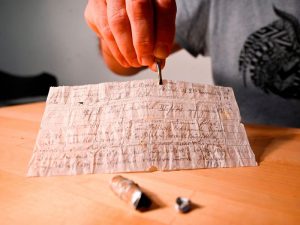
 and it did not get through, finding it now is unfortunately more than a century too late. Halaoui discovered the long-lost message just a few hundred yards from its site of origin, so Jardy suspects that this capsule slipped off the homing pigeon’s leg early in its journey. I hope that is true, because some of these pigeons were shot down. Others were caught by the hungry citizens and used for food, but some made it home and they were heroes of war too, because they brought important intel to the Allies.
and it did not get through, finding it now is unfortunately more than a century too late. Halaoui discovered the long-lost message just a few hundred yards from its site of origin, so Jardy suspects that this capsule slipped off the homing pigeon’s leg early in its journey. I hope that is true, because some of these pigeons were shot down. Others were caught by the hungry citizens and used for food, but some made it home and they were heroes of war too, because they brought important intel to the Allies.
 Most of us know Julia Child as a famous chef, who mainly focused on French cuisine, as well as an author of cookbooks, but that is only one aspect of her life. Born Julia Carolyn McWilliams in Pasadena, California on August 15, 1912, she was the daughter of John McWilliams Jr, and Julia Carolyn “Caro” (Weston) McWilliams. She came from wealth as privilege, her dad being a Princeton Graduate and prominent land manager, and her mom being a paper-company heiress. She was the eldest of three children, followed by John McWilliams III and Dorothy (McWilliams) Cousins. Child and her siblings were all unusually tall, and loved outdoor sports. After she graduated, Julia went on to major in history in college, after college took a job as a copywriter for a furniture company in New York City.
Most of us know Julia Child as a famous chef, who mainly focused on French cuisine, as well as an author of cookbooks, but that is only one aspect of her life. Born Julia Carolyn McWilliams in Pasadena, California on August 15, 1912, she was the daughter of John McWilliams Jr, and Julia Carolyn “Caro” (Weston) McWilliams. She came from wealth as privilege, her dad being a Princeton Graduate and prominent land manager, and her mom being a paper-company heiress. She was the eldest of three children, followed by John McWilliams III and Dorothy (McWilliams) Cousins. Child and her siblings were all unusually tall, and loved outdoor sports. After she graduated, Julia went on to major in history in college, after college took a job as a copywriter for a furniture company in New York City.
With the onset of World War II, Julia tried to enlist in military service, but was told that she was too tall to enlist in the Women’s Army Corps (WACs) or in the U.S. Navy’s WAVES…both facts that make no sense to me, and probably would not have been a factor these days. Nevertheless, Julia was declined that chance to serve. 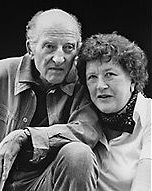 Undeterred, she joined the Office of Strategic Services (OSS) as a typist at its headquarters in Washington but, because of her education and experience, soon was given a more responsible position as a top-secret researcher working directly for the head of OSS, General William J. Donovan. Thus began a career that would lead to being a spy for the Allied forces and have a life changing effect on Julia’s life.
Undeterred, she joined the Office of Strategic Services (OSS) as a typist at its headquarters in Washington but, because of her education and experience, soon was given a more responsible position as a top-secret researcher working directly for the head of OSS, General William J. Donovan. Thus began a career that would lead to being a spy for the Allied forces and have a life changing effect on Julia’s life.
In 1944, she was posted to Kandy, Ceylon (now Sri Lanka). Her responsibilities included “registering, cataloging and channeling a great volume of highly classified communications” for the OSS’s clandestine stations in Asia. Later she was transferred to Kunming, China, where she received the Emblem of Meritorious Civilian Service as head of the Registry of the OSS Secretariat. Asked to solve the problem of too many OSS underwater explosives being set off by curious sharks, “Child’s solution was to experiment with cooking various concoctions as a shark repellent,” a task she did in a bathtub…not much like her cooking in later years. The chemicals were sprinkled in the water near the explosives and repelled sharks…it was a great success and is still in use today. The experimental shark repellent “marked Child’s first foray into the  world of cooking” Child received an award that cited her many virtues, including her “drive and inherent cheerfulness.”
world of cooking” Child received an award that cited her many virtues, including her “drive and inherent cheerfulness.”
While in Kunming, she met Paul Cushing Child, also an OSS employee, and the two were married September 1, 1946, in Lumberville, Pennsylvania. They later relocated to Washington DC. Paul was a New Jersey native who had lived in Paris as an artist and poet. He was also known for his sophisticated palate, and introduced his wife to fine cuisine. Julia had always had a cook in her childhood home, so the idea of cooking was very foreign to her. Still, she was smart, and she began to excel in the art of cooking. It was her cooking that helped her to realize another of her goals…to become an author. Cooking was not a goal is a girl, but it was her later love of cooking that finally gave her the title of writer she had so desired. While Julia and Paul never had children, they lived a long and happy life until his passing in 1994. Then she went on until her own passing in 2004 at the good old age of 91.
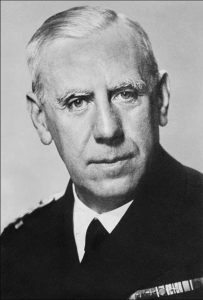 Wilhelm Canaris was born January 1, 1887, in Aplerbeck, Germany. The Germans celebrated him as a war hero during the First World War, for his many exploits as a submarine captain. Canaris later became a top military spy for Germany. He was appointed to head the Abwehr Military Intelligence in 1935. It seemed a fitting next step in a celebrated military officer’s career, but Canaris was not exactly what he seemed to be on the outside. I suppose that as a spy, that makes sense. Spies, by definition have to live life on the fringes, with few people really allowed to know the real man. Canaris had the added complication of being a double agent.
Wilhelm Canaris was born January 1, 1887, in Aplerbeck, Germany. The Germans celebrated him as a war hero during the First World War, for his many exploits as a submarine captain. Canaris later became a top military spy for Germany. He was appointed to head the Abwehr Military Intelligence in 1935. It seemed a fitting next step in a celebrated military officer’s career, but Canaris was not exactly what he seemed to be on the outside. I suppose that as a spy, that makes sense. Spies, by definition have to live life on the fringes, with few people really allowed to know the real man. Canaris had the added complication of being a double agent.
Canaris…the man behind the Nazi Abwehr spy network, was a shrewd, brilliant spymaster who managed to keep control of the Abwehr. He also outwitted Himmler at almost every turn, while joined with other high-ranking German officers in a dangerous plot to eliminate Hitler and make a separate peace with the Allies. I believe there were many German people, and military personnel who did not agree with Hitler, and some were brave enough to do something about it.
Admiral Wilhelm Canaris is the number one mystery man of the Nazi regime under Hitler to this day. Historians have argued his value for years. I’m sure many of them were convinced that he was actually working with the Nazis, instead of against them from the inside. Canaris stayed so tightly in his shell, probably a means of self-preservation, that he didn’t talk much, but was rather a great listener. Almost everybody who knew him didn’t really know exactly what his purpose and intentions were. The ability to be a good listener is a vital part of being a spy…as is the ability to keep your mouth shut about things. Rattling off too much information in a spy network, can get a spy killed.
Canaris, on the one hand, was the great protector of the German opposition against Hitler. On the other hand, he was the one who prepared all the big expansion plans for the acts and crimes of Hitler in the Third Reich. He had to protect and motivate the opposition members, all of whom were eager to fight against Hitler, and it had to appear that he was hunting them as conspirators. It was one of the many difficult contradictions Canaris was forced to live with to stay in control of the Abwehr. There were, of course, ugly sides to his job too. Canaris was an eye-witness to the killing of civilians in Poland. At Bedzin, SS troops pushed 200 Jews into a synagogue and then set it on fire. They all burned to death. Canaris was in shock. On September 10, 1939, he had to travel to the front to watch the German Army in action. This also gave him the opportunity to meet with his intelligence officers, who told him of insane massacres. Two days later, Canaris went to Hitler’s headquarters train…the Amerika, in Upper Silesia, to protest. He first saw General Wilhelm Keitel, Chief of the Armed Forces High Command. “I have information,” Canaris told Keitel, “that mass executions are being planned in Poland and that members of the Polish nobility and the clergy have been singled out for extermination.” He apparently had no idea of Hitler’s real plan for the “final solution.”
Canaris told Keitel, “The world will one day hold the Wehrmacht responsible for these methods since these things are taking place under its nose.” Keitel told Canaris to take the matter no further. I’m sure that Keitel made it clear that Canaris’ life depended on keeping his mouth shut about these things. Canaris did as he was told, or so the Nazis thought. Before long, however, the Vatican began to receive regular, detailed reports of Nazi atrocities in Poland. The information had been gathered by agents of the Abwehr by order of Canaris, who passed them on to Dr Josef Muller, who was a devout Catholic and a leading figure in the Catholic resistance to Hitler. Muller, in turn, got the reports safely to Rome. Canaris sent another of his colleagues, Pastor Dietrich Bonhoeffer, on a flight to Sweden to meet secretly with Bishop Bell of Chichester. Bonhoeffer told Bell of the crimes his nation was committing, and assured Bell of growing resistance in Germany to such acts. In March 1943, Canaris personally flew to Smolensk to plan Hitler’s assassination with conspirators on the staff of Army Group Center.
The efforts of Canaris were later made clear during the Nuremburg Trials, but it was too late for Canaris. He had made strenuous efforts in trying to put a stop to the crimes of war and genocide committed by Hitler. Admiral Canaris, along with his second-in-command, Hans Oster, actually helped the Allies while supervising all German espionage, counterespionage, and sabotage. He revealed almost all of the important German strategy and battle plans to the Allies. From Hitler’s impending western offensive against the Low countries and France to Hitler’s plan to invade Britain. Canaris also misled Hitler into believing that the Allies would not land at Anzio in 1943. The work Canaris was doing against became evident to Hitler only after the conspirators attempted to kill him in July 1944. Canaris and many others were arrested. The principal prisoners were confined at Gestapo cellars at Prinz Albrechtstrasse. Canaris was kept in solitary confinement, in chains. Canaris’ cell door was permanently open, and the light burned continually, day and night. He was given only one third of the normal prison rations. As winter set in, his starved body suffered cruelly from the cold. He was also humiliated by being forced to do menial jobs, such as scrubbing the prison floor, the SS men mocking him.
On February 7, 1945, Canaris was brought to the Flossenburg concentration camp. His treatment did not improve there. He was still treated badly, and often endured having his face slapped by the SS guards. Nevertheless, Canaris baffled the SS interrogators with one ruse after another, and he denied all personal complicity in the conspiracy. He never betrayed his fellow participants in the Resistance Movement. During the last weeks of the Nazi era, SS Obersturmbannführer Walter Huppenkothen and Sturmbannführer Otto Thorbeck were sent to Flossenburg to eliminate Canaris and the other resistance figures. A bogus “trial” was held, after which the men hung the victims. A few more days and the war would have been over, but in the gray morning hours of April 9, 1945, gallows were erected hastily in the courtyard for Wilhelm Canaris, Dietrich Bonhoeffer, Major General Hans Oster, Judge Advocate General Carl Sack, Captain Ludwig Gehre. The men were ordered to remove their clothing and were led down the steps under the trees to the secluded place of execution before hooting SS guards. Naked under the scaffold, they were allowed to pray one last time, then they were hanged, and their corpses left to rot. Two weeks later, on April 23, 1945, the camp was liberated by American troops.
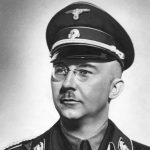

Admiral Wilhelm Canaris was a true hero, in the face of unbelievable odds. I’m sure he know that he would get caught at some point, and I’m equally sure that he knew he would be killed, when he was caught. Nevertheless, he said of his actions, “I die for my fatherland. I have a clear conscience. I only did my duty to my country when I tried to oppose the criminal folly of Hitler.” He knew that his death was worth fighting the evil that was the Third Reich. I only wish that he had survived so that he could have been properly honored.
 The life of a spy is a dangerous one. Getting caught spying is often punishable by death, so the key to being a successful…and later old spy, is not to get killed, and therefore not to get caught. The spies had a number of way so fool the Nazis. One of the ways was to research the proper clothing for the area and the times, and make sure that the clothing of the spy didn’t stand out as being foreign or outdated. To miscalculated that aspect of the spy, could mean certain death.
The life of a spy is a dangerous one. Getting caught spying is often punishable by death, so the key to being a successful…and later old spy, is not to get killed, and therefore not to get caught. The spies had a number of way so fool the Nazis. One of the ways was to research the proper clothing for the area and the times, and make sure that the clothing of the spy didn’t stand out as being foreign or outdated. To miscalculated that aspect of the spy, could mean certain death.
Clothing wasn’t always the concern. When a spy is being followed, footprints can be very telling. One of the ways that the spies fooled the Nazis was the spy shoes they wore. The shoes were very functional as a way to disguise what was going on, but the looked hilarious. The idea of the shoes was to make the person following the spy think that  the spy was going the opposite direction from that which the spy was really going. Basically, the shoe was put on the sole backwards. That way, the person following the spy, would think he was walking toward the spy, when he was actually walking away from him. The technique gave the spy precious time to get far away from the enemy who was tracking him. The only problem for the spy was the shape of the shoe. It seems to me that the shape of the shoe would feel very odd to the spy. Nevertheless, the shoe was necessary, and so the spy got used to it. I suppose the feeling was similar to a child putting their shoes on the wrong feet. It is thought that the shoes might have first been used by Moonshiners during the prohibition period.
the spy was going the opposite direction from that which the spy was really going. Basically, the shoe was put on the sole backwards. That way, the person following the spy, would think he was walking toward the spy, when he was actually walking away from him. The technique gave the spy precious time to get far away from the enemy who was tracking him. The only problem for the spy was the shape of the shoe. It seems to me that the shape of the shoe would feel very odd to the spy. Nevertheless, the shoe was necessary, and so the spy got used to it. I suppose the feeling was similar to a child putting their shoes on the wrong feet. It is thought that the shoes might have first been used by Moonshiners during the prohibition period.
Our more modern day thought concerning spy shoes and other equipment is probably far more advanced. The shoes might have contained a knife in the heel or even a shoe phone, like Maxwell Smart…on the show “Get  Smart.” Of course, much of that is fiction, and I don’t know if real modern day spies even use special shoes or any other special spy tools, for that matter. The Backward Spy Shoes were a very simple tool, but it would seem that they were highly effective during World War II. The only problem I see with a shoe that takes a tracker back to the starting point of the spy who is being pursued is that it would make it impossible to return to the point of origin for fear of being tracked there. Of course if the spy walked to a public place, like a train station, and then switched shoes, they could easily get lost in the crowd, never to be found. Either way, the shoes were a clever way to outsmart the enemy.
Smart.” Of course, much of that is fiction, and I don’t know if real modern day spies even use special shoes or any other special spy tools, for that matter. The Backward Spy Shoes were a very simple tool, but it would seem that they were highly effective during World War II. The only problem I see with a shoe that takes a tracker back to the starting point of the spy who is being pursued is that it would make it impossible to return to the point of origin for fear of being tracked there. Of course if the spy walked to a public place, like a train station, and then switched shoes, they could easily get lost in the crowd, never to be found. Either way, the shoes were a clever way to outsmart the enemy.
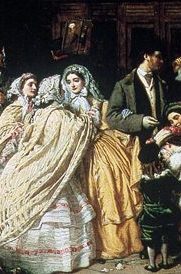 These days, with all the television shows about secret agents, undercover cops, and spies, most of us wouldn’t think twice about one of those positions being held by a woman. During the American Civil War, however, which basically coincided with the Victorian era, one of the most morally repressive eras in history for women, things were different. Everything from a woman’s dress to her education were tightly constricted by moral attitudes that governed her every action. Basically, women were to concentrate their “war efforts” on the task of supporting their husband, brothers, or fathers, in whatever their beliefs were toward the matter. However, as the war dragged on and more men were called into active duty, the farms, factories, stores, and schools were left without workers, so the women stepped up to stand in the gap, as it were. This was most surprising because, back then, women were considered too frail, and their minds too simple for things like politics and war. They were designed for keeping the home and taking care of the babies. Nevertheless, when the men were called into active duty, most of them would have lost their farms, homes, and businesses had it not been for the strength and intelligence of the of the “frail and simple” women. Many women refused to limit their assistance to their country to what could be accomplished close to home. Some of them became nurses, worked to raise supplies for their troops, or even worked in armories, but there was a number of these women decided to support their country in a more dangerous…and scandalous way…they became spies.Back then, espionage was considered a very dishonorable pursuit for a man during the Civil War era, but for a woman…it was tantamount to prostitution. Nevertheless, with the war raging, women of both the North and South flaunted the Victorian morality of the time to provide their country the intelligence it needed to make tactical and practical decisions.
These days, with all the television shows about secret agents, undercover cops, and spies, most of us wouldn’t think twice about one of those positions being held by a woman. During the American Civil War, however, which basically coincided with the Victorian era, one of the most morally repressive eras in history for women, things were different. Everything from a woman’s dress to her education were tightly constricted by moral attitudes that governed her every action. Basically, women were to concentrate their “war efforts” on the task of supporting their husband, brothers, or fathers, in whatever their beliefs were toward the matter. However, as the war dragged on and more men were called into active duty, the farms, factories, stores, and schools were left without workers, so the women stepped up to stand in the gap, as it were. This was most surprising because, back then, women were considered too frail, and their minds too simple for things like politics and war. They were designed for keeping the home and taking care of the babies. Nevertheless, when the men were called into active duty, most of them would have lost their farms, homes, and businesses had it not been for the strength and intelligence of the of the “frail and simple” women. Many women refused to limit their assistance to their country to what could be accomplished close to home. Some of them became nurses, worked to raise supplies for their troops, or even worked in armories, but there was a number of these women decided to support their country in a more dangerous…and scandalous way…they became spies.Back then, espionage was considered a very dishonorable pursuit for a man during the Civil War era, but for a woman…it was tantamount to prostitution. Nevertheless, with the war raging, women of both the North and South flaunted the Victorian morality of the time to provide their country the intelligence it needed to make tactical and practical decisions.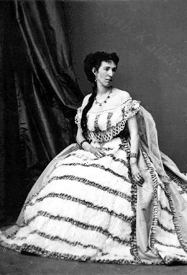
The most famous of these female spies was Belle Boyd…born Marie Isabella Boyd. She began spying for the Confederacy when Union troops invaded her Martinsburg, Virginia home in 1861. One of the Federal soldiers manhandled her mother, and Boyd shot and killed him. She was exonerated in the soldier’s death, and an emboldened Boyd managed to befriend the Union soldiers left to guard her, and used her slave, Eliza, to pass information confided in her by the soldiers along to Confederate officers. Boyd was caught at her first attempt at spying, and threatened with death, but she did not stop her activities. She vowed to find a better way instead. She began eavesdropping on union officers staying at her father’s hotel. She learned enough to inform General Stonewall Jackson about their regiment and activities. Taking no chances, this time, Boyd delivered her intelligence firsthand, moving through Union lines, and reportedly drawing close enough to the action to return with bullet holes in her skirts. The information she provided allowed the Confederate army to advance on Federal troops at Fort Royal. Boyd’s daring acts of espionage soon caught up with her again and when a beau gave her up to Union authorities in 1862, she was arrested and held in the Old Capitol Prison in Washington for a month. Then she released, but found herself in the arrested again soon after. Once again, she managed to be set free, and this time she traveled to England, where amazingly, she married not a Confederate soldier, but a Union officer.
Boyd wasn’t the only spy in the Civil War. Another famous female spy was nicknamed “Crazy Bet,” but her real 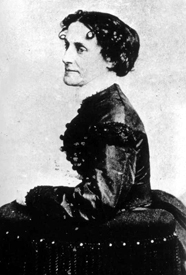 name was Elizabeth Van Lew. Van Lew was born to a wealthy and prominent Richmond family, and was educated by Quakers in Philadelphia. When she returned to Richmond, she had become an abolitionist. She even went so far as to convince her mother to free the family’s slaves. Her espionage activity began soon after the start of the war. Her neighbors were appalled, because she openly supported the Union. She concentrated her efforts on aiding Federal prisoners at the Libby Prison, by taking them food, books, and paper. Later, she smuggled information about Confederate activities from the prisoners to Union officers, including General Ulysses S. Grant. To hide her activities from her Confederate neighbors, she behaved oddly. She dressed in old clothes, talking to herself, and refusing to comb her hair. Believe it or not, people began to think she was insane. They started calling her “Crazy Bet.” Van Lew wasn’t insane, in fact, she was incredibly intelligent. She was hailed by Grant as the provider of some of the most important intelligence gathered during the war.
name was Elizabeth Van Lew. Van Lew was born to a wealthy and prominent Richmond family, and was educated by Quakers in Philadelphia. When she returned to Richmond, she had become an abolitionist. She even went so far as to convince her mother to free the family’s slaves. Her espionage activity began soon after the start of the war. Her neighbors were appalled, because she openly supported the Union. She concentrated her efforts on aiding Federal prisoners at the Libby Prison, by taking them food, books, and paper. Later, she smuggled information about Confederate activities from the prisoners to Union officers, including General Ulysses S. Grant. To hide her activities from her Confederate neighbors, she behaved oddly. She dressed in old clothes, talking to herself, and refusing to comb her hair. Believe it or not, people began to think she was insane. They started calling her “Crazy Bet.” Van Lew wasn’t insane, in fact, she was incredibly intelligent. She was hailed by Grant as the provider of some of the most important intelligence gathered during the war.
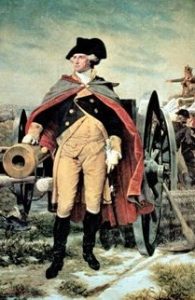
 How many Generals can say that a housewife saved their life? Not many, I’m sure. Most housewives would never get near enough to a general in combat to do anything, but in the 1700s, things were different. Of course, it wasn’t like Philadelphia housewife and nurse Lydia Darragh, got out there and fought along-side General Washington and his Continental Army, but she was, nevertheless, able to single-handedly save their lives when she overheard the British planning a surprise attack on Washington’s army for the following day. Some say this is just a legend, and I guess we will never know for sure, but the story has endured for 240 years, which says something to me.
How many Generals can say that a housewife saved their life? Not many, I’m sure. Most housewives would never get near enough to a general in combat to do anything, but in the 1700s, things were different. Of course, it wasn’t like Philadelphia housewife and nurse Lydia Darragh, got out there and fought along-side General Washington and his Continental Army, but she was, nevertheless, able to single-handedly save their lives when she overheard the British planning a surprise attack on Washington’s army for the following day. Some say this is just a legend, and I guess we will never know for sure, but the story has endured for 240 years, which says something to me.
This historic event happened on December 2, 1777, during the occupation of Philadelphia. British General William Howe had stationed his headquarters across the street from the Darragh home. When Howe’s headquarters proved too small to hold meetings, he commandeered a large upstairs room in the Darraghs’ house. Although uncorroborated, family legend holds that Mrs. Darragh used to eavesdrop and take notes on the British meetings from an adjoining room and would conceal the notes by sewing them into her coat before passing them onto American troops stationed outside the city. It was a critical mistake on the part of the British, and the ingenious way of passing the information worked very well for the patriots.
On the evening of December 2, 1777, Darragh overheard the British commanders planning a surprise attack on Washington’s army at Whitemarsh, Pennsylvania, for December 4th and 5th. Somehow, it completely amazes me that they would be so careless with the information, especially considering the fact that they were in the home of the enemy. I guess they assumed that the housewife would have no idea what the “great military minds” were thinking or talking about, nor that she would have any way to pass the information to anyone who could do anything about it. I’m sure they were completely shocked when they realized that she had tipped General Washington off to the plot, and saved the lies of him and his army…as well as saving the day.
Using a cover story that she needed to buy flour from a nearby mill just outside the British line, Darragh passed the information to American Lieutenant Colonel Thomas Craig the following day. The British marched towards Whitemarsh on the evening of December 4, 1777, and were surprised to find General Washington and 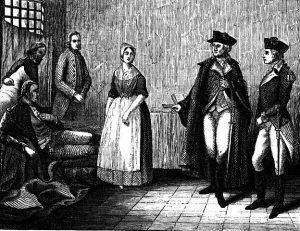
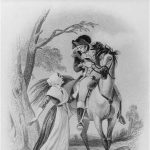 the Continental Army waiting for them. After three inconclusive days of skirmishing, General Howe chose to return his troops to Philadelphia. It’s an amazing victory for General Washington and his Continental Army, and it all happened because a patriot housewife turned spy for her country. When you think about it, she already had the perfect disguise for the job. It is said that members of the Central Intelligence Agency still tell the story of one of the first spies in American history.
the Continental Army waiting for them. After three inconclusive days of skirmishing, General Howe chose to return his troops to Philadelphia. It’s an amazing victory for General Washington and his Continental Army, and it all happened because a patriot housewife turned spy for her country. When you think about it, she already had the perfect disguise for the job. It is said that members of the Central Intelligence Agency still tell the story of one of the first spies in American history.

